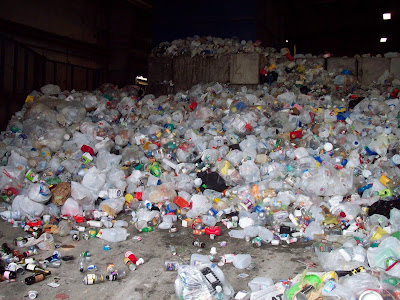The Basics
Madison County has a two stream recycling center. Thus, as the name implies, we must separate our recyclables into two streams: 1) Paper and paper-based products must go in one container (to keep it dry and clean) and 2) aluminum, metal, glass, and plastic products must go in another container.
Paper and Cardboard
The golden rule of cardboard recycling: if it sits in your cupboard, it’s the perfect recyclable material! For example, cereal and granola bar boxes and even greasy pizza boxes can all be recycled. If you store it in the fridge or freezer, keep it out! This is because these cardboard products contain a plastic-like material that prevents them from falling apart when they become moist. Unfortunately, this material also contaminates paper recycling. For example, soda/beer boxes and cardboard milk containers must be thrown in the trash.
Aluminum, Metal, Glass and Plastic
The Madison County facility is able to recycle all 1-7 plastic products. But, before you throw your plastic in the recycle bin, make sure is “squeezable.” Another golden rule: if you squeeze it and it cracks, it’s trash; if you squeeze it and it’s pliable, it’s recyclable!
A few other tips: make sure to keep all Styrofoam products out of your recycling bin, clean your containers before discarding them and spend the extra second to drain your bottles and take the tops off (otherwise, someone else has to do it for you- think about unscrewing the caps off of hundreds of bottles a day).
Other Recycling Products
Yes, you can recycle your plastic bags from the grocery store. That is, if you aren’t already using a reusable one or reusing them yourself. Fill up one bag with others and put them in with your paper recycling bin. Also, you can recycle old clothing (shirts and shorts – yes; socks and underwear – no!). These products donated or used to make rags and other products. Once again, keep these in a dry bag and place them in your paper recycling bin. Lastly, if you have any old pots and pans, feel free to put them to good use! Throw them in a separate bag or put them in with the paper.
Recycling Solid Waste for Energy
The Madison County facility is at the forefront of utilizing renewable energy technologies. The facility has topped the landfill with thin and flexible solar panels.
PHOTO: Flexible solar PV array on capped landfill cell.
This solar PV array is estimated to generate 40,000 kWh’s of power per year; that’s enough to provide electricity to approximately 30,000 homes. In addition to this new project, the landfill is capturing the methane that is produced from the breakdown of solid waste. The methane is piped and combusted to provide 1,000 kilowatts of electricity per hour; that is enough to heat 200 homes per year. Moreover, the by-product is heat that is used to heat all of the facilities buildings!
If any of your basic recycling questions have not been answered, be on the look out for the first-ever Colgate Recyclepedia! Also, be sure to keep others informed! Education and awareness are the first steps towards a more sustainable future.









